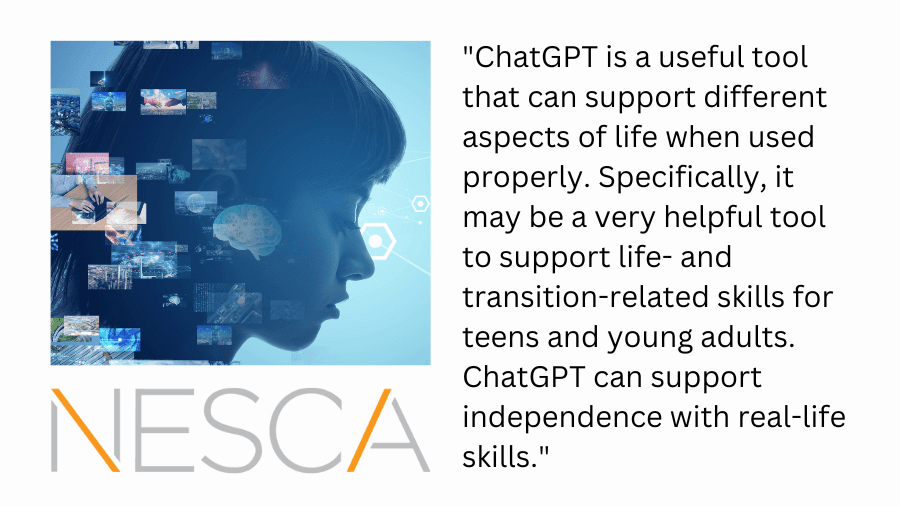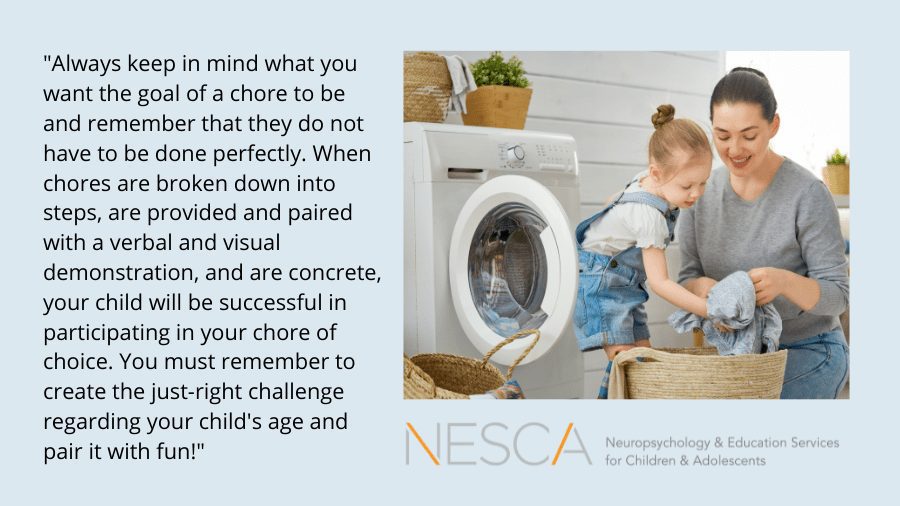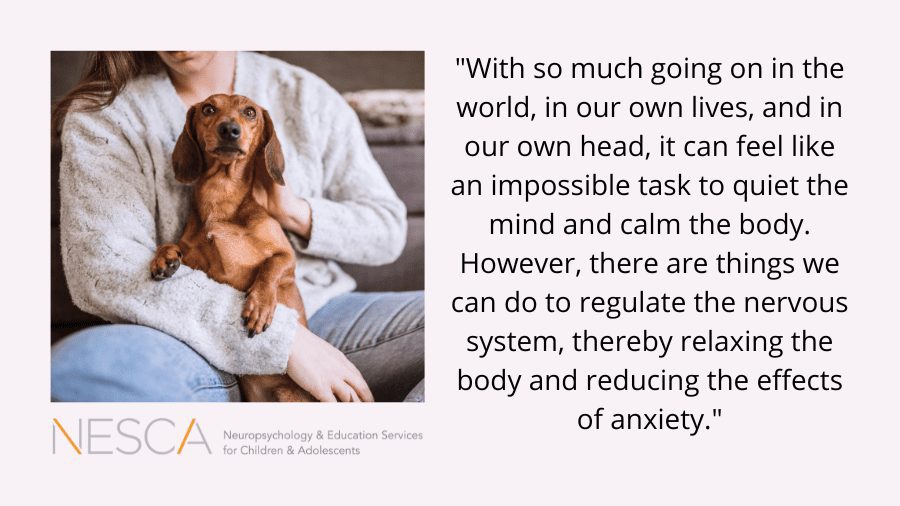 By: Lyndsay Wood, OTD, OTR/L
By: Lyndsay Wood, OTD, OTR/L
NESCA Transition Specialist & Occupational Therapist
Recently there has been a lot of talk in the media about artificial intelligence (AI) technology and the impact it will have on the world. With the recent development of ChatGPT and other AI technologies, the way we work, learn, and live may see some significant changes. While change can be difficult – and there are often many considerations to make before adopting a new technology system – ChatGPT is a useful tool that can support different aspects of life when used properly. Specifically, it may be a very helpful tool to support life- and transition-related skills for teens and young adults. Here are four ways that ChatGPT can support independence with real-life skills.
1.Meal Planning and Grocery Lists: Often meal planning can be daunting, and it heavily relies on strong executive functioning skills. To make this process easier, AI technology can be utilized. Simply tell ChatGPT that you would like a meal plan for the week (or any amount of time you desire), and it will create a specific meal plan and provide the grocery list if requested. It will also break down the nutritional value if requested. You can input dietary restrictions or any special considerations, and ChatGPT will create a plan in seconds. Below is an example of the prompt I provided and the response I received.
Prompt I input: Create a one-day vegan meal plan with a grocery list. Make sure it is high in protein.
Response from ChatGPT:
Breakfast:
- Tofu Scramble with Spinach and Mushrooms
- 1 block of firm tofu
- 1 cup of spinach
- 1 cup of sliced mushrooms
- 1 tbsp of olive oil
- 1/4 tsp of turmeric
- Salt and pepper to taste
- 2 slices of whole grain toast
Snack:
- Apple and Almond Butter
- 1 apple
- 2 tbsp of almond butter
Lunch:
- Quinoa and Black Bean Salad
- 1 cup of cooked quinoa
- 1/2 cup of black beans
- 1/2 cup of diced bell peppers
- 1/2 cup of diced tomatoes
- 1/4 cup of chopped cilantro
- 1/4 cup of diced red onion
- 1 tbsp of olive oil
- 1 tbsp of lime juice
- Salt and pepper to taste
Snack:
- Roasted Chickpeas
- 1 can of chickpeas
- 1 tbsp of olive oil
- 1 tsp of paprika
- 1/2 tsp of cumin
- Salt and pepper to taste
Dinner:
- Lentil and Vegetable Stir Fry
- 1 cup of cooked lentils
- 1 cup of mixed vegetables (broccoli, carrots, bell peppers, etc.)
- 1 tbsp of olive oil
- 1 tbsp of soy sauce
- 1/2 tsp of garlic powder
- Salt and pepper to taste
- 1 cup of brown rice
Grocery List:
- Tofu
- Spinach
- Mushrooms
- Whole grain bread
- Apple
- Almond Butter
- Quinoa
- Black beans
- Bell peppers
- Tomatoes
- Cilantro
- Red onion
- Olive oil
- Lime juice
- Chickpeas
- Paprika
- Cumin
- Lentils
- Mixed vegetables
- Soy sauce
- Garlic powder
- Brown rice
This meal plan provides approximately 90 grams of protein, which is well above the recommended daily intake for most people.
2. Role Playing Social Scenarios: ChatGPT can create role playing scenarios to help teens and young adults navigate challenging or new social situations. This can help teens figure out what wording they may want to use and what someone may say in response to prepare for an interaction. Below is an example of a role play created by ChatGPT to practice social introductions.
Prompt I input: I am trying to make friends. What is a good way to introduce myself to a classmate? What might she say back? Can you create a role play?
Response from ChatGPT:
Role Play:
You: Hi there! My name is Jane. What’s your name?
Classmate: Hi, Jane! I’m Sarah.
You: Nice to meet you, Sarah! How’s your day going so far?
Classmate: It’s going pretty well, thanks for asking. How about you?
You: It’s going pretty good too. I’m excited to be in this class. What do you think about it so far?
Classmate: Yeah, me too! I’m really interested in the subject matter. What about you?
You: Same here! I think it’s going to be really interesting. Hey, do you want to grab lunch together sometime this week and chat more about the class?
Classmate: That sounds great! I would love to. How about Thursday?
You: Thursday works for me. Let’s plan on meeting in the cafeteria at noon?
Classmate: Perfect. I’ll see you then!
You: Great! Looking forward to it. See you on Thursday, Sarah.
Classmate: See you then, Jane!
3. Writing Professional Emails: Many teens and young adults struggle with composing professional emails. Determining what to say and making it professional can be very difficult for folks who struggle with social pragmatics, written language, anxiety, and executive functioning. When provided with a prompt, ChatGPT can help support this skill. Below is a sample email composed by ChatGPT to ask a professor for an extension on an assignment because the student has been sick.
Prompt I input: Write a professional email to my professor asking for extended time on a project because I am sick.
Response from ChatGPT:
Subject: Request for an Extension on Project Submission
Dear Professor [Name],
I am writing to request an extension on the project submission deadline, which is due on [date]. Unfortunately, I have been unwell for the past few days, and I have been unable to work on the project as planned. I am currently under medication and resting to recover fully.
I am aware that the project is a crucial part of our coursework, and I understand the importance of meeting the deadline. However, given my current health condition, I am finding it challenging to complete the project on time. I am hoping that you can grant me an extension of [number of days] days to submit the project.
I assure you that I will utilize the extended time to work diligently on the project and submit it as soon as possible. I am willing to accept any penalty that comes with the late submission, and I am committed to ensuring that the quality of my work is not compromised.
Thank you for considering my request. I appreciate your understanding and support during this challenging time. Please let me know if you require any further information or clarification.
Sincerely,
[Your Name]
4. Job Applications: ChatGPT can provide a significant amount of support around job applications. ChatGPT can create a resume template, provide cover letter examples, outline a cover letter, and create sample interview questions. Below is a sample outline created by ChatGPT for a cover letter to Starbucks.
Prompt I input: Create an outline for a cover letter to Starbucks
Response from ChatGPT:
Introduction
- Briefly introduce yourself and express your interest in working for Starbucks
Relevant experience and skills
- Highlight any previous experience or skills that would make you a good fit for the company
- Mention any experience working in customer service or the food and beverage industry
- Emphasize your ability to work in a fast-paced environment and handle multiple tasks at once
Passion for coffee and the Starbucks brand
- Discuss your love for coffee and how it has influenced your desire to work for Starbucks
- Mention any knowledge you have about the company’s values and mission
Availability and willingness to learn
- State your availability to work and any flexibility in your schedule
- Express your eagerness to learn and grow within the company
Closing
- Thank the reader for considering your application and express your excitement for the opportunity to join the Starbucks team.
These four examples are just a few of the many ways that AI can help support our teens and young adults with real-life skills. As with anything that is computer-generated, it is important to teach our teens and young adults to review the output and modify information for their needs or to match their own voice. It is exciting to see how these methods will evolve and be utilized in the classroom to supplement and support learning and independence in the future.
Note: it is important to make sure to check school/company policies around AI prior to using the technology and to remember that AI is not human and therefore may not afford the “human touch” that helps with some activities.
About Lyndsay Wood, OTD, OTR/L
Lyndsay Wood, OTD, OTR/L, is an occupational therapist who focuses on helping students and young adults with disabilities to build meaningful skills in order to reach their goals. She has spent the majority of her career working in a private school for students with ASD. She has also spent some time working in an inpatient mental health setting. Lyndsay uses occupation-based interventions and strategies to develop life skills, executive functioning, and emotional regulation. While completely her doctoral degree at MGH Institute of Health Professions, Lyndsay worked with the Boston Center for Independent Living to evaluate transition age services. She uses the results from her research to deliver services in a way that is most beneficial for clients. Specifically, she focuses on hands-on, occupation-based learning that is tailored the client’s goals and interests.
meaningful skills in order to reach their goals. She has spent the majority of her career working in a private school for students with ASD. She has also spent some time working in an inpatient mental health setting. Lyndsay uses occupation-based interventions and strategies to develop life skills, executive functioning, and emotional regulation. While completely her doctoral degree at MGH Institute of Health Professions, Lyndsay worked with the Boston Center for Independent Living to evaluate transition age services. She uses the results from her research to deliver services in a way that is most beneficial for clients. Specifically, she focuses on hands-on, occupation-based learning that is tailored the client’s goals and interests.
To book coaching and transition services at NESCA, complete NESCA’s online intake form.
NESCA is a pediatric neuropsychology practice and integrative treatment center with offices in Newton and Plainville, Massachusetts, Londonderry, New Hampshire, and Burlington, Vermont, serving clients from preschool through young adulthood and their families. For more information, please email info@nesca-newton.com or call 617-658-9800.

 By: Lyndsay Wood, OTD, OTR/L
By: Lyndsay Wood, OTD, OTR/L meaningful skills in order to reach their goals. She has spent the majority of her career working in a private school for students with ASD. She has also spent some time working in an inpatient mental health setting. Lyndsay uses occupation-based interventions and strategies to develop life skills, executive functioning, and emotional regulation. While completely her doctoral degree at MGH Institute of Health Professions, Lyndsay worked with the Boston Center for Independent Living to evaluate transition age services. She uses the results from her research to deliver services in a way that is most beneficial for clients. Specifically, she focuses on hands-on, occupation-based learning that is tailored the client’s goals and interests.
meaningful skills in order to reach their goals. She has spent the majority of her career working in a private school for students with ASD. She has also spent some time working in an inpatient mental health setting. Lyndsay uses occupation-based interventions and strategies to develop life skills, executive functioning, and emotional regulation. While completely her doctoral degree at MGH Institute of Health Professions, Lyndsay worked with the Boston Center for Independent Living to evaluate transition age services. She uses the results from her research to deliver services in a way that is most beneficial for clients. Specifically, she focuses on hands-on, occupation-based learning that is tailored the client’s goals and interests.









 meaningful skills in order to reach their goals. She has spent the majority of her career working in a private school for students with ASD. She has also spent some time working in an inpatient mental health setting. Lyndsay uses occupation-based interventions and strategies to develop life skills, executive functioning, and emotional regulation. While completely her doctoral degree at MGH Institute of Health Professions, Lyndsay worked with the Boston Center for Independent Living to evaluate transition age services. She uses the results from her research to deliver services in a way that is most beneficial for clients. Specifically, she focuses on hands-on, occupation-based learning that is tailored the client’s goals and interests.
meaningful skills in order to reach their goals. She has spent the majority of her career working in a private school for students with ASD. She has also spent some time working in an inpatient mental health setting. Lyndsay uses occupation-based interventions and strategies to develop life skills, executive functioning, and emotional regulation. While completely her doctoral degree at MGH Institute of Health Professions, Lyndsay worked with the Boston Center for Independent Living to evaluate transition age services. She uses the results from her research to deliver services in a way that is most beneficial for clients. Specifically, she focuses on hands-on, occupation-based learning that is tailored the client’s goals and interests.



Connect with Us